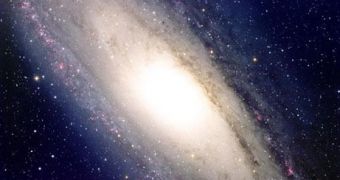It is widely believed that every galaxy in the universe hosts a supermassive black hole at its core, with a mass ranging between ten thousand and a few billion times that of the Sun. Marc Sigar from the University of Arkansas claims that with the help of images provided by the Hubble Space Telescope, he and his team established a relationship between the mass of the central supermassive black hole and the arms wrapped around spiral galaxies.
According to Seigar, the more massive the black hole is, the tighter the arms of the galaxy will wrap around it. "This means that to determine the mass of a supermassive black hole, you only need an image of a galaxy", said Seigar.
Since black holes emit none to little electromagnetic radiation, they are basically invisible to us. However, it is possible to measure them by observing the effects produced by the massive gravitational field in the surrounding areas, such as on the motion of the stars in its vicinity. A fast orbiting star for example, can reveal the presence of a massive object that would be invisible otherwise.
However, in the case of more distant galaxies, observations on individual stars may not be available, thus another technique must be used to weigh the supermassive black holes they are hiding. Seigar realized that galaxies housing relatively small black holes had their spiral arms positioned at as much as 43 degrees in relation to each other and the galactic nuclei and spiral galaxies with supermassive black holes in their centers had arms at angles of approximately 7 degrees.
"The real significance of this is that it is relatively easy to detect spiral structure in galaxies, even out to distances of eight billion light-years. So we can estimate the masses of very distant black holes now and determine how black holes grow over time", Seigar said.
Galactic mergers
The images provided by the Hubble Space Telescope also allow astronomers to understand how objects such as starburst and quasar galaxies form and support the idea that the evolution of galaxies is greatly influenced by gravitational interactions and mergers, said Mike Brotherton from the University of Wyoming.
Galaxies that merge in order to create a new galaxy provide the basis for 'starburst' periods, when stars are being born at an incredible rate, even if such events are hidden by the material resulted in the merging. At the same time, the supermassive black hole of the merger may be fueled with large amounts of matter to create a quasi-stellar object, a quasar, which is basically a black hole surrounded by a large, hot accretion disk of matter that clears the debris of dust and gas to reveal the young stars.
Such an object was discovered in the late 1990s and was later identified by Hubble as being the remnant of a merger. Since then, more than 600 quasars have been identified.
"The images started coming in, and we were blown away. We see not only merger remnants - but also post-starburst quasars with interacting companion galaxies, double nuclei, starbursting rings, and all sorts of messy structures", said Brotherton.
Additionally, observations made by Mederic Boquien from the University of Massachusetts with the Spitzer Space Telescope, Galaxy Evolution Explorer and some eight other ground based telescopes on six interacting galaxies located within 375 million light years from Earth, showed that about 85 percent of newly born stars form in the debris of the merger and not inside that of the original galaxies.
"The best regions to study star formation would be those completely devoid of old stars, and we were able to find some regions which satisfy these criteria. As star formation apparently occurs in a similar way in galaxies, results we obtain studying intergalactic star-forming regions can be confidently extended to galaxies", Boquien said.

 14 DAY TRIAL //
14 DAY TRIAL //